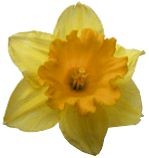|
______________________________________________________
About
Daffodils

"There
is magic in the garden. I cannot create a daffodil
in all its color and grace. No one can. I do
not know how a daffodil is created. Yet each spring
thousands and thousands of them are seen dancing in our
gardens. There is law in the garden. It is the
law of creation. If we follow the law we deal in
magic. We cannot see the stuff of which a daffodil
is made, we need not care by what process it comes into
being. If we take the brown bulb, plant it
accordingly to the law at the right time -- we achieve a
miracle."
~ Roy E. Biles
Species:
Narcissus spp.
Family: Amaryllidaceae
Common Names: Daffodil, Narcissus, Jonquil
Your grandmother may have called them jonquils and your
mother said they were daffodils, but the horticultural
texts all call them narcissus, its botanical name.
Daffodil,
Narcissus and Jonquil were once separate flowers. Thanks
to plant hybridizers who have been busy bees over the last
150 years, there are more than 5,000 different varieties
of daffodils.
>>
Glorious
photos of the thirteen divisions of daffodils
Colors
include yellow, orange, red orange, pink, cream, green,
yellows, greens, white, coppery and bicolor shades. They
come in many forms, including doubles and miniatures.

I
wish more people would grow daffodils. Here are some
easy instructions for you so you may plant a cluster or
two this fall:
How
hard are they to grow?
Daffodils
are perhaps the most carefree flowering plants I know.
It's hard to go wrong with them, as they almost never let
you down. Trust me, they are so easy to grow!
-
They
are exceedingly low-maintenance. You
can pretty much plant them as bulbs and forget them. Some
seem to even thrive on neglect.
-
They
multiply freely. What
a great investment! Hard to believe, but in
those humble onion-looking bulbs are daffodils coiled
within its genetic layers and even more amazing, it is
programmed to do the trick year after year, almost
indefinitely. Amazing!
-
They
are hardy. In
the spring, these marvels sprout with the greatest of ease, coming
back through all variations of weather and
circumstance short of a layer of asphalt.
-
They
are pest-resistant. Unlike
tulip bulbs, squirrels, chipmunks and deer usually stay clear of
daffodil bulbs, which is reported to be the vilest tasting
bulbs, besides being poisonous. Bugs hate them and
they are relatively disease-resistant as well.
When
should you plant daffodils?
As
spring-flowering bulbs, daffodils must be planted in the
fall. Daffodils should be planted as soon as they are
purchased in the fall; poor storage can damage the flower
bud or actually kill the bulb.
The
bulbs require time to develop a good root system before
cold weather sets in and the soil freezes so for this
reason, planting before the end of November is generally
best.
Soil
essentials:
With
good drainage they thrive in most soils, although they
prefer a medium-heavy loam. The bulbs tend to rot in wet
areas. Choose a well-drained area.
To
get your soil free-draining, modify the soil with the
addition of organic material, plenty of grit or sharp sand
and extra drainage. If drainage cannot be improved, raised
beds should be built.
Sun
or shade?
Simple
rule of thumb: give it as much sunlight as you can, but
plant it anywhere other than the deep shade. Avoid
the north sides of buildings.
The
bulb wants at least a half day of sunshine. Although
they will grow in partial shade, they always thrive in
full sun.
Bunches
or singles?
Bunches.
Bunches and bunches.
"Try
to avoid being safe all the time.
Safe is a hairsbreadth
away from boring and utterly forgettable.
If in doubt, go
a bit overboard.
Better to make an impact with your
flowers
than to have them go unnoticed."
~ Carolyn Roehm
Unlike
hyacinths and tulips,
daffodils are not at their best in even rows or geometric
beds. They look best when planted with
light-fingered abandon in clumps. A single daffodil just
doesn't have the same effect. More is better.
Yes, it is. And if you plant them all together in
one mass bed, they will be spectacular.
Give
the bulbs room; plant the bulbs 3-5 inches apart.
Overcrowding will reduce the bulbs' ability to produce
more bulbs and flowers each year. This ability to spread
is called "naturalizing."
Whether
you've plant them in a rock garden, open field, formal
bed, along paths, or in pots and other containers, they
will brighten up your spring like no other flower can.
How
do I plant the bulbs?
As
Mrs. Gene Bauer does it: one at a time.
A
rule of thumb: measure the length of the bulb and plant it
two to three times as deep as it is long. If it is three
inches long, plant the bulb so its top is six inches deep.
Generally, the bulbs are planted with the "neck"
area 4 or 5 inches beneath the soil. Deeper is better on
the planting-you don't want to plant too shallow.
Water
well and spread some compost after planting, and keep them
watered if you are having a dry spell. As a general
rule of thumb, do not water daffodils during the summer.
Mulch
is fine to use after planting, especially in the colder
climates. Mulch can be pine needles, leaves that have been
sitting and are moist and starting to decompose, wood
chips or shredded wood, even grass clippings can be used.
There’s
more to it than just throwing down a bunch of pine
needles. Topsoil can crack in extreme heat.
Mulch can prevent this thus saving your plants'
roots from stress, dehydration, and eventual death.
Natural mulch breaks down, adding organic matter to your
soil and thereby enriching it over time.
What's
this about inter-planting for succession blooming?
Inter-planting
is a good idea. Plant the daffodil bulbs alternately with daylilies.
The brilliant golden colors of the daffodils dominate the
walk in early spring, but as the daffodil flowers fade and
the leaves yellow, the daylily foliage emerges and masks
the spent daffodils. The daylily flowers provide a second
season of brilliant color ranging from deep red and orange
to palest pink and yellow.
Consider other adding other companion plants, such as kale
for the fall and pansies or violas for the spring.
Gardeners in mild climates can try pansies or violas in
the fall, and they will likely bloom all winter long.
Pansies in dark blues make a striking contrast to the
yellow daffodils. Violas are also a good choice because
they don't require as much light as pansies do. Just plant
the companion plant directly over the daffodils. This is
called over-planting. When the bulbs emerge in the spring,
they will grow through the pansies and violas.
They are also good to plant beneath deciduous shrubs, so
that after they have finished flowering the emerging
leaves of the shrub will hide the mess of the daffodil
leaves without swamping all light from them.
If your area is
dry during the summer, you may leave your bulbs.
Just mulch the bed. If you water, or grow other things
there, then you must dig them and store them. WARMTH +
MOISTURE = BULB ROT.
Wash the
bulbs thoroughly. Dry them for at least a week, out of the
sun. Store them in onion sacks (or panty hose). Hang in a
cool place with good air circulation.
How
should I feed my daffodils?
Give
it a shovel of compost every spring, and they will thrive.
Or, fertilize as you do your other bulbs, such as tulips
and crocus.
Daffodils
do not require heavy fertilization. When preparing
planting beds, incorporate from 2 to 3 pounds of a
complete garden fertilizer such as a 5-10-5 into100 square
feet of soil. Packaged bulb food is convenient to use, and
it can either be soil incorporated or applied over the
soil surface after planting. In established plantings, the
bulbs will benefit from a complete slow-release fertilizer
applied over the soil surface to give the bulbs a boost as
they develop their new roots.
Never
place fertilizer directly in the bottom of the hole. A
high fertilizer concentration can kill newly emerging
roots and promote rot.
Shy
away from using organic fertilizer such as bonemeal when
planting bulbs as it can attract rodents (gophers and
moles). If you own a dog or have a yard
frequented by your neighbor's dog or other animals, it
might be advisable to use superphosphate rather than have
the animals dig for the "bones" they think they
have buried in your garden.
Then
what do I do?
Then
sit back and wait for spring for a glorious display of
bright sunlight yellow and demonstration of why
daffodils are the traditional symbol of spring.
Oh
yeah, and don't pick them singly or bring them in
the house if you raise chickens or goslings. And
PLEASE do not eat the bulbs! (see
Daffodil
Lore for details)
Tell
me about daffodils as cut flowers.
Daffodil
blooms last two to three weeks.
When
you cut daffodils from the garden, do so at an angle, so
that the inner tissue is exposed and water can be drawn up
better. They will last longer if you leave the stems in
shallow, tepid water for a couple of hours in a dark room
before arranging them. The vase-life is four to eight
days.
What
do I do when the flowers are spent?
After
flowering, the foliage of the daffodils should not be cut
back until it has browned naturally, nor should it be
allowed to die back too early from lack of water.
Do
not bundle leaves with a rubber band or braid them
together—you want as much of the leaf surface exposed to
the sun as possible. Through photosynthesis, leaves
provide the bulb with crucial energy for the next year's
flowers.
And
come back to this Web site to ease your daffodil
withdrawals. (Bookmark
this site.)
And
remember:
"There
are no gardening mistakes, only experiments."
~.Janet Kilburn Phillips

Links
to P. Allen Smith's web site:

>>
Next: Daffodil
Lore (Fascinating!)



|

View Our GuestMap
|
Where
are you from? Please sign our
GuestMap, a cool alternative to the GuestBook and LOTS
more fun! We'd love to know
where you're visiting from. Click on the icon to the left and follow the
simple instructions.
 First,
stick
a pushpin where you live; then, if you wish,
share your thoughts on daffodils and
this Web site in the comments window. Thank you! First,
stick
a pushpin where you live; then, if you wish,
share your thoughts on daffodils and
this Web site in the comments window. Thank you! |
| The
Legend of The Daffodil Garden | About
the Garden | Visitor
Info: When and Where | A
Virtual Walking Tour | (Alma)
Gene and Dale Bauer | The
Daffodil Garden Fact Sheet | About
Daffodils | Daffodil
Lore | Daffodil
Art | Daffodil
Sayings & Quotes | Daffodil
Odes | Daffodil
Links | Site
Map |

"The
only gift is a portion of thyself."
~
Ralph
Waldo Emerson
|